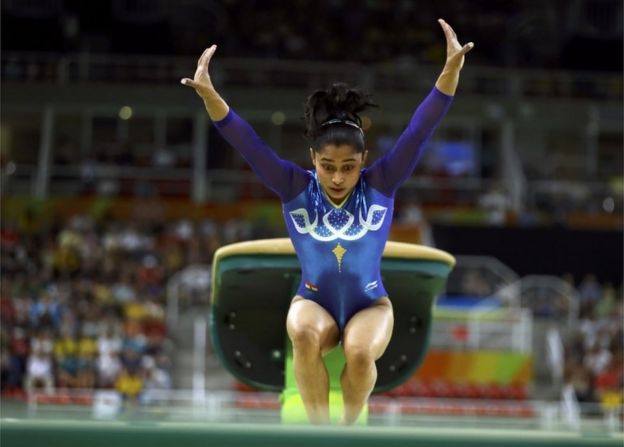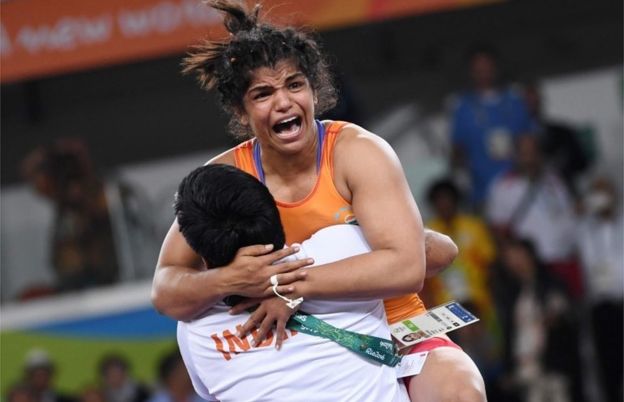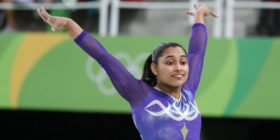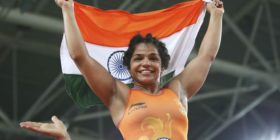On Friday evening, a 21-year-old became the first Indian woman to win a silver medal at the Olympic Games.
Ninth seeded shuttler PV Sindhu, lithe and lethal on court, also became the youngest Indian ever to win an Olympic medal.
In a riveting 84-minute game, she fought like a tigress before going down to the world champion Spaniard Carolina Marin in the women’s badminton final.
On Wednesday, female wrestler Sakshi Malik had ended India’s medal drought at Rio: she picked up the bronze in the 58kg women’s wrestling category, becoming the first Indian female wrestler and the fourth Indian woman to win an Olympic medal.
Last Sunday, Dipa Karmakar, India’s first female gymnast at the Olympics, just lost out on a medal, finishing fourth in the women’s vault gymnastics, and winning the hearts of a nation.
“After a miserable first week full of teary near-misses and a few underwhelming sub-scripts, a gymnast, a wrestler and a badminton player were to spark the 2016 Olympics to life for Indians,” says sports writer Sharda Ugra.
Creating history
In other, more modest achievements, long-distance runner Lalita Babar became the second Indian woman to qualify for the final of track and field event at Olympics, finishing 10th in the 3,000m steeplechase final on Monday; and teenage golfer Aditi Ashok qualified for the final.
Clearly, women athletes are making history – and saving India’s face at Rio.
It is difficult to think of another instance where women saved the country’s reputation at an international sporting event since India’s best track-and-field athlete PT Usha won four of five gold medals in the 1987 Asian Games. Women won two of the six medals India picked up in London 2012. “There has definitely been a resurgence in women’s sport if you see the break up of Olympic medals,” says Ronojoy Sen, author of a definitive history of sport in India.
Indian women have indeed come a long way in sport since Nilima Ghose and Mary D’Souza joined the contingent of athletes at the 1952 Helsinki Olympics. Long before then, Jenny Sandison, an Anglo-Indian from Bengal, played at Wimbledon in 1918, and lost in the first round. In 1934, Leela Row, another Anglo-Indian, became the first Indian woman to win a match in Wimbledon. Much later, in 1952, Rita Davar, became the runner-up in the junior girls event at Wimbledon.
In track and field, women made slower strides. In the 1954 Asian Games in Manila, the Indian women’s relay team picked up a gold; and in the next games in Tokyo in 1958, Stephie D’Souza won a silver medal. A hockey tournament for women began in 1947, and a women’s team participated for the first time in an international hockey tournament in 1953 in England.
‘Affluent and westernised’

Yet, before Independence and in the years after it, Indian sportswomen were gentrified and belonged to affluent, westernised communities. “Before 1947, hockey and basketball were the two most popular sports among women in India, even though it was mostly Europeans, Anglo-Indians, and Parsis who played them,” says Sen.
No longer. With a deepening of democracy, rising aspiration and improved and more accessible facilities in many states, most sports in India are no longer the preserve of the rich.
The number of female sports icons is also growing. Top-ranking badminton player and Olympics bronze-winner Saina Nehwal, daughter of a government employee, is believed to be one of the richest woman athletes in India. Tennis star Sania Mirza, a former number one in doubles, is also idolised by many. Boxer Mary Kom, Olympic bronze-medallist and five-time world champion, is the daughter of a landless farmer from the remote and troubled state of Manipur where, according to one writer, “aspiration is not even visible on its streets”. Kom has inspired a bunch of women boxers from the state.
The rise and rise of women in sports also mirrors the intense social churning in India.
Take, for example, Sakshi Malik, 23, who began wrestling 12 years ago only because she “wanted to fly on a plane and visit a foreign country”.

Paradox
She hails from a village in Haryana, a northern state with a dreadful sex ratio of 879 women per 1,000 men – her village actually fares worse. Born to a transport worker father and a government child and primary education care mother, she holds a masters degree in physical education, and lives in a two-storey building with a Volkswagen Polo in the front porch. Her brother runs the village’s only Subway sandwich franchise.
Paradoxically, a state infamous for its low sex ratio, kangaroo courts, women in veils and stark patriarchy is producing a large number of women athletes: 12 of the 20-strong contingent from Haryana to Rio are women.
The new generation of Indian sportswomen are also the grittiest of them all. Dipa Karmakar risked her life to perform the Produnova vault, widely known as one of the most dangerous feats in gymnastics; Malik overcame deficits in the dying seconds of her bout, and Sindhu, minutes after a spell of losing 7 out of 9 points, won 11 consecutive points to reach the final.
“They are severe risk takers, have a never-say-die determination and a seething killer instinct. These are not qualities we associate with Indians, and certainly not its women,” says writer and filmmaker Jaideep Varma.
“It can’t just be a coincidence, can it? Is something significantly transformative going on here? Something that goes beyond pride, beyond women, and beyond sport?”
Sociologist Ravinder Kaur believes the performances in sport clearly show that Indian women “wish to write their own futures”.
“More and more young girls want to break barriers and fulfil the same ambitions as men or their own ambitions and are less afraid and less cowed down by societal controls,” she says. This is truly revolutionary.





Leave a reply